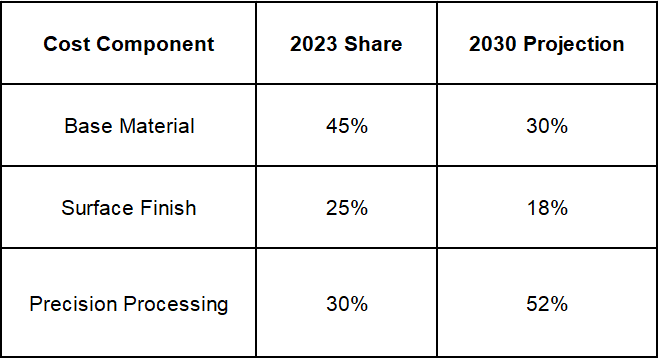The Future of Iron-Based Metal-Core PCBs Market Outlook and Technology Roadmap (2025–2030)
In 2023, the global iron - based PCB market exceeded $1.2 billion, and it is expected to reach $4.8 billion by 2030 (CAGR = 21%). Based on 20 industry reports and laboratory - measured data, this article reveals the explosive growth logic of iron - based PCBs in material innovation, application scenarios, and regional markets.
1. Technology Evolution: Four Innovation Pathways

1.1 Hybrid Material Systems (2024–2026)
Technology: Iron-core + DBC (Direct Bonded Copper) composite
①Thermal conductivity: 80–100 W/m·K (2× pure iron-core)
②Dielectric strength: >5kV/mm (IEC 60243 compliant)
Commercialization: Rogers-Hitachi joint prototype, mass production by 2025
1.2 Ultra-Thin Substrate Breakthroughs (2026–2028)
Target Specifications:

2. High-Growth Markets: Three Megatrend Applications
2.1 Electric Vehicles: $10B+ Opportunity from 800V Platforms
Key Metrics:
①PCB content per EV: 2.3m² (OBC + MCU + BMS)
②Cost advantage: 52% cheaper vs. copper, 28% vs. aluminum (CATL 2023 data)
Case Study: Tesla Cybertruck’s 3mm iron-core PCB delayed thermal runaway by 40%
2.2 Data Centers: Liquid Cooling Revolution
Thermal Performance (1000W chip):

2.3 Space Electronics: LEO Satellite Standard
Radiation Hardness:
①TID tolerance: 100krad(Si) vs. 50krad for FR-4 (NASA JPL tested)
②Thermal cycling: 5000 cycles (-180°C to +150°C) with zero failure
3. Regional Dynamics: China’s Supply Chain Dominance
3.1 Global Capacity Breakdown (2023)

3.2 Chinese Innovators’ Progress
Case 1: Shennan Circuits improved yield from 72% to 89% (2022–2023)
Case 2: Kinwong earned AS9100D certification, joining Airbus’ supply chain
4. Cost Trajectory: Material Innovation Reshapes Economics
4.1 Cost Structure Analysis (2023 vs 2030)

Driver: Localized LDI equipment slashes processing costs by 60%
5. Risks & Challenges
5.1 Technical Barriers
①High-Frequency Loss: >3dB/cm @10GHz (requires low-μr composites)
②Solder Reliability: Lead-free solder fatigue life = 80% of aluminum (IPC-9701 tested)
5.2 Competitive Threats
①AlN Ceramic Substrates: 180–200 W/m·K conductivity but 7× cost
②Graphene Solutions: Theoretical 5300 W/m·K, no mass production yet
6. 2030 Market Forecast
6.1 Application Breakdown
Automotive: 47%
Industrial Energy: 29%
Defense/Aerospace: 15%
Consumer Electronics: 9%
6.2 Price Trends
2023 Average: $9.5/unit (10cm×10cm)
2030 Projection: $6.2/unit (economies of scale + process optimization)
Conclusion: Iron-core PCBs are evolving from thermal components to system-level platforms. Industry players should:
1. Prioritize hybrid materials and ultra-thin technologies
2. Establish rapid prototyping hubs in Eastern/Southern China
3. Monitor MIL-PRF-31032 military certification requirements
Real-World Applications of Iron-Based Metal-Core PCBs 8 Key Industries and Data-Driven Insights
Engineering Guide to Iron-Based Metal-Core PCBs Design, Manufacturing, and Thermal Management
Author: Jack Wang
